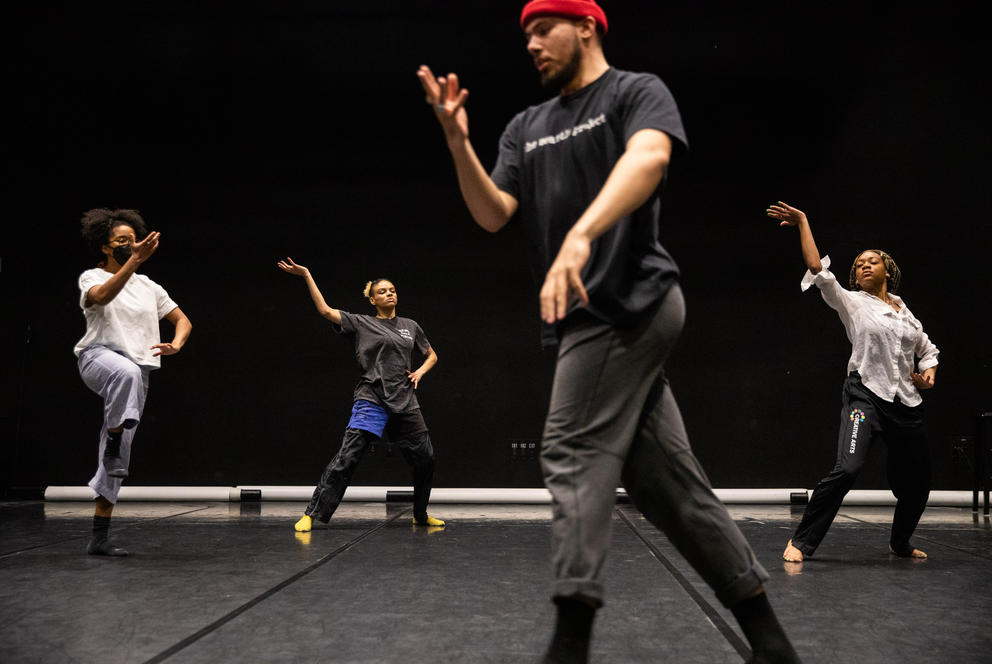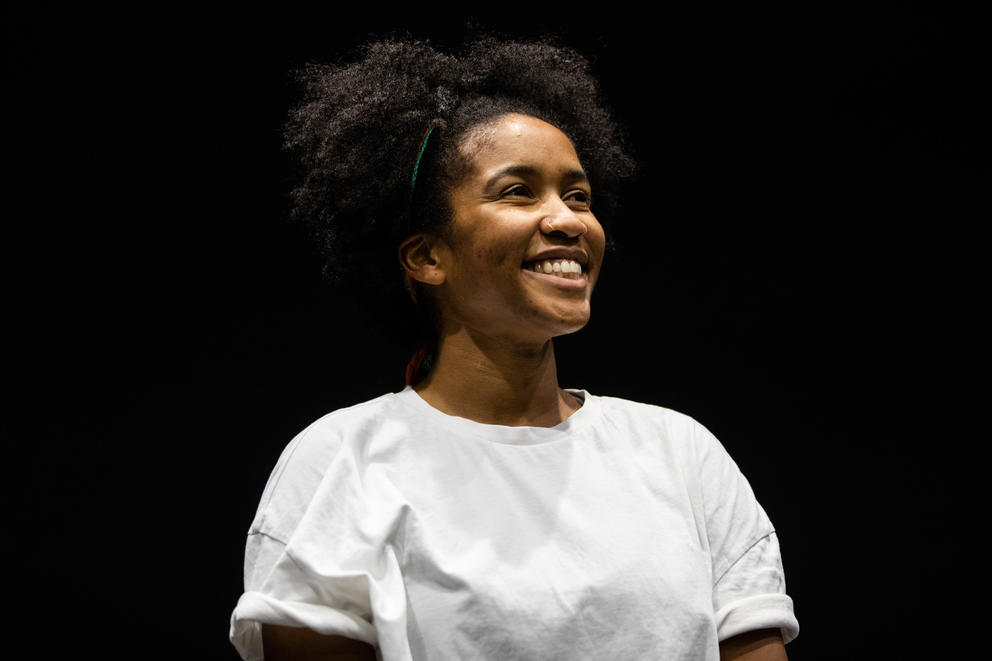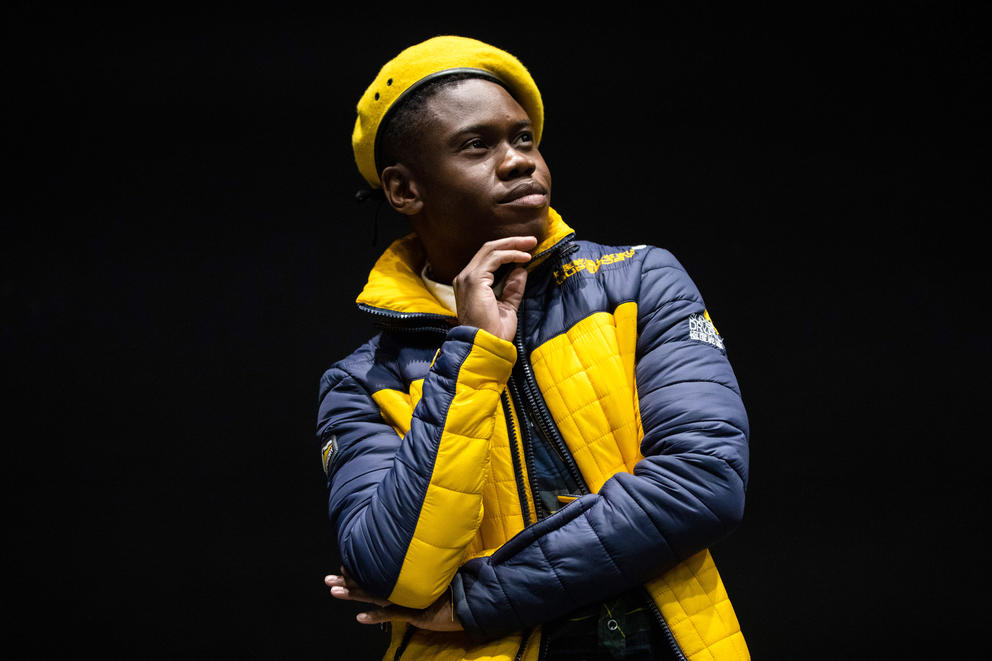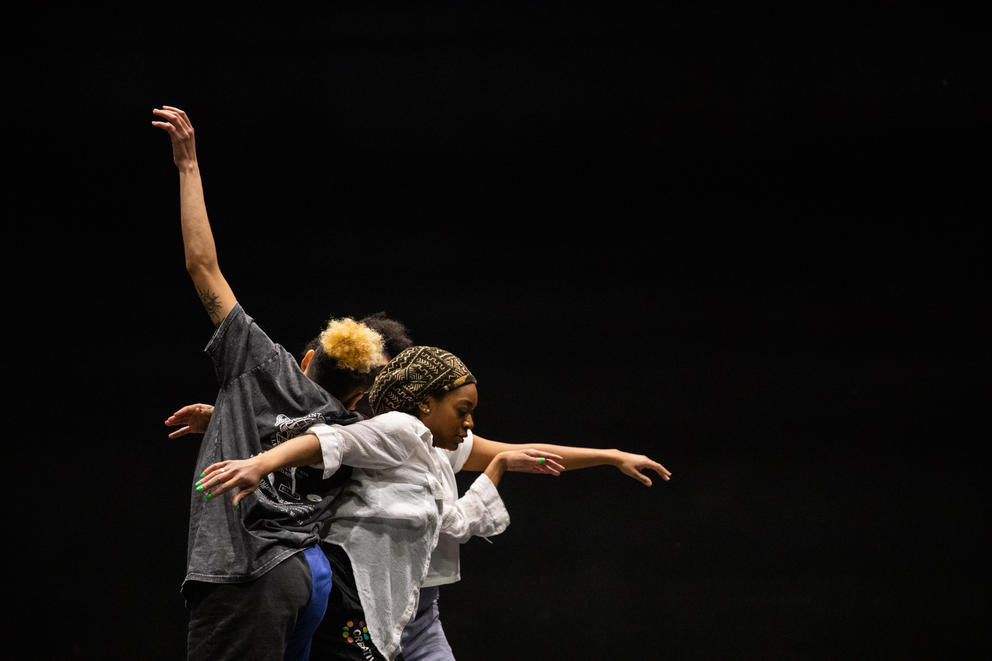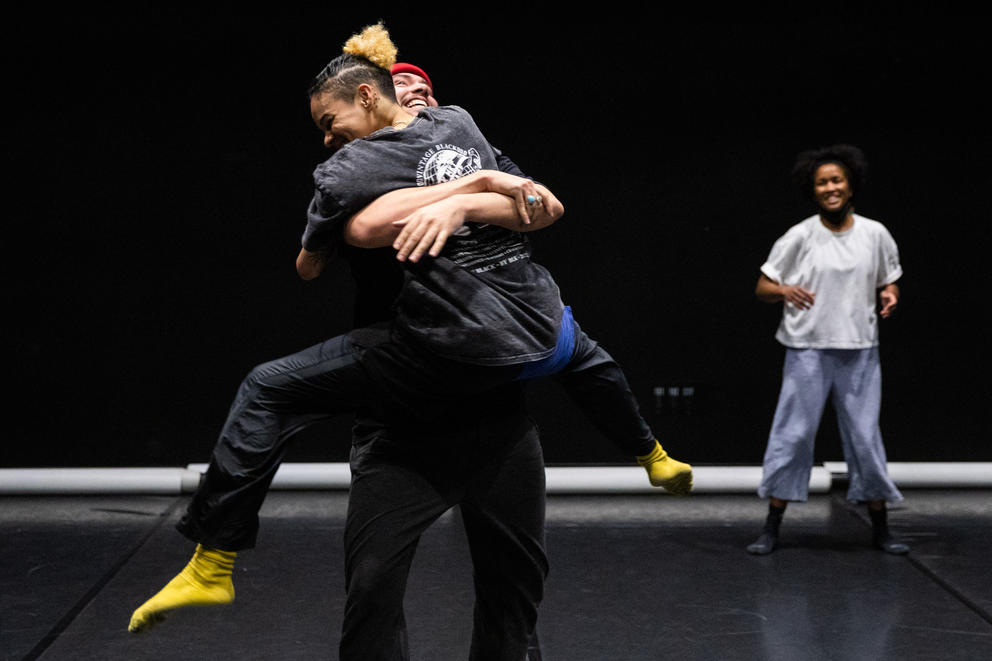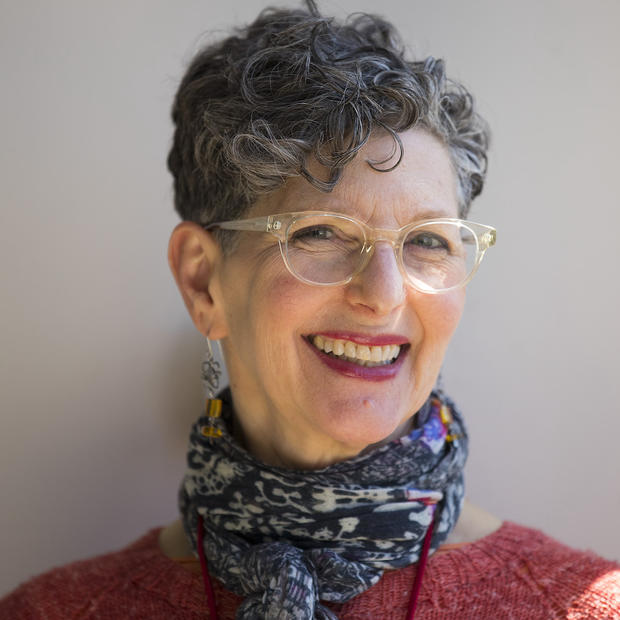But what about Raven Wilkinson? She was Copeland’s mentor and the first African American woman to dance with a major classical ballet company. Or, in Seattle, consider dancers like Syvilla Fort, who in the mid-20th century taught movie stars how to dance, and Edna Daigre, a teacher who trained several generations of professional dancers here.
If you’re not a dance historian or major dance geek, those names are probably unfamiliar. Dance history isn’t generally well-known, and when you’re talking about dancers of color, those histories often have been excluded from the mainstream record altogether.
That’s an omission a group of Seattle artists wants to help rectify. And they’ll do that, in part, by making dances themselves.
The group, Black Collectivity, has spent more than 18 months researching the legacy of Black dancers in Seattle and beyond. That study is culminating in an ambitious project called A Practice of Return.
Black Collectivity presented research findings and screenings of short dance films, as well as a rarely seen 1979 documentary about Fort, in late March at Northwest Film Forum. And this weekend (April 6 - 8 at 12th Avenue Arts), they’ll premiere a new dance performance inspired by the research. All this work has been co-produced with Velocity Dance Center.
“In 2021 Velocity invited me to be part of its Made in Seattle cohort,” says local dancer and choreographer Nia-Amina Minor. “They told me, ‘You have the space to do whatever you want.’ That was coming out of quarantine time, and I was like ‘Whatever I do, I don’t want it to be alone.’”
Minor, who performed with Donald Byrd’s Spectrum Dance Theatre from 2014 to 2017, invited fellow dancers marco farroni leonardo and David Rue to join her. Rue, a dancer and arts administrator who relocated to Los Angeles last fall, has worked with a number of local choreographers, including Dani Tirrell and Zoe Scofield; farroni, another former Spectrum company member, is now creating his own choreography.
“Nia had this brilliant idea of finding ways to document the stories of Black dancers living and working in Seattle who have, perhaps, paved the way for what we do,” says Rue.
The group began its work by digging into the archives at the University of Washington, Cornish College of the Arts and the UW’s Henry Art Gallery, sifting through periodicals and photographs dating back to the 1920s.
When they realized the scope of the work, they enlisted help from a fourth dancer, Seattle native Akoiya Harris, who trained with both the Ailey School — part of the Alvin Ailey American Dance Theater — as well as Spectrum Dance.
Their research turned up dancers like Michael Phelan, who also performed locally as the comic character “Miss Thing” in the late 1940s-early 1950s, and Sarita Allen, a classically trained Seattle native who became an original member of the Alvin Ailey Repertory Ensemble.
But early in their research, the group singled out Syvilla Fort as what Rue calls a “star amongst a constellation of Black dance artists in Seattle.”
Fort, born in Seattle in 1917, showed an early aptitude and passion for dance, especially ballet, but no white teachers would accept her into their schools. Instead her parents brought private dance teachers into their home, quite an expense for a postal clerk and a housekeeper.
By the late 1930s, Fort was one of the first Black students to enroll in what is now Cornish College of the Arts, studying alongside another Washington-born future dance luminary, Merce Cunningham.
Fort went on to a successful career in dance, performing with Katherine Dunham’s troupe (credited as the first African-American modern dance company) and founding her own school with her husband, tap dancer Buddy Phillips, in New York City.
The Phillips-Fort Studio of Theater Dance taught many well-known actors, including Eartha Kitt and James Dean. And, according to Seattle filmmaker B.J. Bullert, Fort may have been the inspiration for the design of the Space Needle.
Fort had an rewarding life in dance, but Black Collectivity was most intrigued by her Cornish recital, which made headlines, on April 28, 1940.
The dance student was accompanied by now-legendary composer John Cage, who had manipulated a piano to provide a wider, more percussive range of sounds for the small school auditorium. It was the first appearance of what came to be known as Cage’s influential “prepared piano.”
Minor tracked down the evening’s program in the Cage archives at Northwestern University, and that information provided the starting point for Black Collectivity’s A Practice of Return performance.
She thinks of Fort as the entry point for an artistic loop.
“It’s so beautiful, so many decades in the future, to be Black dancers in Seattle thinking back on her,” she says. “The past is in the present and the future is now.”
Rather than recreating Fort’s dances, the group choreographed original work using her recital as thematic inspiration. Accordingly, the piece moves from quiet nocturnes to rhythmic interludes to a jazz-inflected finale.
At a recent rehearsal, Rue, who’d traveled up from LA to be at the research presentation, watched carefully as his fellow collaborators, plus local dancer Jiamond Elizabeth, ran through the opening section of their performance.
Although he’d watched earlier rehearsals over Zoom, Rue hadn’t been part of the day-to-day process of making the dance, so he was curious to see how the four performers had manipulated the historical research into dance steps.
“This project has been unlike most creative practices I’ve done,” Rue noted. “How can we explore this kind of historical, archival research and translate it for a dancing Black body?”
At the dancers’ cue, Rue started up Chari Glogovac-Smith’s soundtrack, which mixed audio recordings of insects and birds with slow, almost eerie piano chords from recordings by 20th-century jazz pianist Hazel Scott.
To the rising sounds of hooting owls and chirping crickets, the four dancers swirled around one another, arms snaking around their intertwined bodies. The overall effect resembled a moss-draped tree in a primeval forest.
This choreography is an amalgam of images Black Collectivity collected during their long research phase. Their inspiration includes photos of Fort, dating back to her time at Cornish dancing with Merce Cunningham, as well as some of photographer Al Smith’s images from the dance floors of Seattle’s thriving jazz club scene in the mid-20th century.
“We passed the pictures around,” Minor explains, “creating tableaux, gestures or vignettes from them. Some are pretty iconic, like the photo of Syvilla with her arms up.” Minor flings both arms into the air, curving them gently over her head, to demonstrate.
She likens the process to sewing together scraps of fabric to create a quilt. “It’s really quite phenomenal to conceive of these bits and pieces that, put together, create a complex story of history, of memories. I hope people walking into our show feel like they’re walking into this beautiful tapestry we’re trying to weave,” Minor says.
While the four collaborators were fascinated by Fort’s story, the deeper they dug into the archives, the further the project expanded beyond Seattle to encompass the myriad dance traditions that have emerged from the African Diaspora. They wove strands of tap, jitterbug and Fort’s beloved ballet around more traditional African village dances, creating multilayered movement.
Preserving the past by making new performance works inspired by it is something Jasmine Mahmoud, an assistant professor of theater history and performance studies at the University of Washington, calls “embodied history.”
“The site of knowledge is not just dusty boxes in archives, although that’s what society values,” says Mahmoud, who has worked with Black Collectivity to present their research findings (and served as project editor for Crosscut’s Black Arts Legacies project).
When Mahmoud talks about “embodied action,” she means turning the written archives into dance or movement that a present-day audience can watch.
In the case of Black Collectivity’s project, it means taking the movements that they read about or saw in old photographs, and putting them into this new dance. “Embodied actions help to access the knowledge, especially for those who have been marginalized,” Mahmoud says.
Dancer Akoiya Harris agrees. Having spent the past year recording Black oral histories for the Central District arts center Wa Na Wari, she’s now turning the skills she gained on that project toward collecting stories about Seattle’s Black dance community.
“We remember through rhythm, we remember through repetition, we remember through storytelling,” says Harris. “Listening to people talk about their memory of dance is something we can anchor to as we start to make steps that feel new.”
A Practice of Return has been both time-consuming and ambitious, an undertaking most emerging artists could never afford. Velocity Dance Center’s Made in Seattle commission provided the artists with seed money and the freedom to create whatever they wanted.
Shane Donohue, Velocity’s Creative Producer, calls the funding program “the pinnacle” of Velocity’s commitment to supporting experimental contemporary dance. For every Made in Seattle commission like this one, Velocity extends invitations to selected artists, provides seed money up to $15,000, then works with the artists to help fund everything from salaries to technical production costs.
Not only does Velocity fund creation of new dances, it also helps pay for costs associated with producing the performance, with no requirement that the artists reimburse those costs from ticket sales revenue. “We’re giving this to artists in order for them to have a more sustainable future,” Donohue says.
Despite spending 18 months enveloped in history, the future is top of mind for Black Collectivity. According to farroni, A Practice of Return is only the beginning of what the group hopes will be a continuing conversation about how history can pave the way for Seattle’s Black arts community.
After this weekend’s performance, Black Collectivity will have completed their work with Velocity’s Made in Seattle project. But members intend to stay connected with other projects currently digging into Seattle arts archives, exploring more ways to make their research findings accessible to the public.
“When I moved to Seattle [in 2017], I didn’t know the deep, rich history that exists here,” farroni says. “I hope people are inspired to engage with these histories. Because 100 years from now, our future ancestors are going to look back on us and say, ‘Oh, they did this too!’”
Get the latest in local arts and culture
This weekly newsletter brings arts news and cultural events straight to your inbox.

